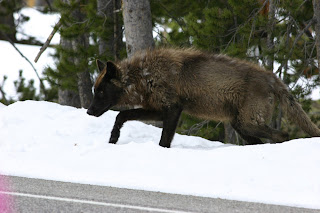Thursday, May 7, 2009
Last day in YNP
We had lunch at the Sawtooth deli in Gardiner. It was snowing and raining in Mammoth so we are going back later to hike the hot springs before dinner at the Town Cafe. After lunch we cleaned up the lodge and now we are waiting to head to the hot springs. The weather still looks bad, but as we have learned it could be sunny in Mammoth and the weather will change, probably in the next 10 minutes.
That's all for now. It's been a great trip all around.
Perhaps we will get some pictures of the wolves that have denned up near Mammoth (the former Canyon Pack) and will share them later. But if not. See you in Lexington. We are leaving for Bozeman at 4:45 AM for our 7:30 flight.
May 6 Wrapping up in the field and packing up the lab
After field work we came back and packed up the lab and I finished the presentation for the Yellowstone Center for Resources for tomorrow.
Tuesday, May 5, 2009
Canyon, Yellowstone Lake and more weather
We stopped at Mud Volcano/Churning caldron (yes correct spelling). Pretty cool geology even though it smells like rotten eggs. The video below is of the Churning caldron.

Then we stopped at the Grand Canyon of Yellowstone.

On the way back through, and now with blue skys, we got to see the same Grizzly grazing on some fresh green grass from 100 yards. Plenty of pictures were taken.

On the way back to Gardiner we got stuck in yet another Bison jam. I took some close ups this time.

When we got back to Gardiner clouds were still to thick to do soil respiration using the solar panel so we hit main street Gardiner and did some souvenir shopping. After an hour it looked clear so we set up to do species specific soil respiration. I took half of the group back to the lodge to sieve soils for future analysis and on my return back to Gardiner (25 min later) the weather had turned quickly and put a stop to respiration after one replicate.
Within 10 minutes of leaving the field site we got to see a rainbow over Gardiner and the sun quickly came back out.

Tomorow we hope to get soil respiration done and we will take our final soil cores from the SBU experiment and remove our fungal soil tubes that we installed 10 days ago. Then it will be time to pack up samples and the lab and get them back to Lexington. Time flies.....
Monday, May 4, 2009
Not a predator in sight but a good day in the field.
Tomorrow we will set up another lab urease incubation experiment and go back out to GB to quantify soil respiration for species specific soils.
Sunday, May 3, 2009
Alyssum hunting = Grizzly


Above is a Bufflehead duck that was being harrassed by a Barrows Goldeneye duck (Below).

So after we finished the Slough Creek hike we headed back towards Specimen to find an ALDE waypoint. Nearly to the destination we see a load of RV's, cars and spotting scopes. We happened upon a grizzly eating an unknown (to us) kill on the Lamar river. The waypoint we were looking for turned out to be on the river bank and probably 1/4 mile from the grizzly so we didn't look for ALDE, but we got great pictures and video, once again. We are really fortunate. Seven wolves and 2 grizzlies on three different kills, all within 3 days.


Tomorrow we will be conducting another lab incubation of soils with simulated bovine urine and an inhbitor of urease. Plus we will be going out to quantify soil respiration in the field and sample soil in the restoration site prior to seeding (which may occur this week).
Saturday, May 2, 2009
A quick taste


Friday, May 1, 2009
Success
This wolf crossed the road in front of us near the old Picnic stop in the Lamar valley. We then looked to the left and saw it's partner still on a kill. We couldn't see the kill but knew it was there based on all of the birds hanging around.
This is the wolf that was still on the kill and then left and gave us a good opportunity to get pictures.
Evening update: After an exciting (close to once in a lifetime) morning we came back and took a quick brek. Then we went out to set up another SBU experiment in Gardiner Basin. The weather the day before didn't make for the best 24h sampling so we started over again.
Not a bad field site (when the sun is shining)


Tomorrow we are going to head down to Old Faithful and Canyon and then sample our SBU expeiment in the afternoon.




